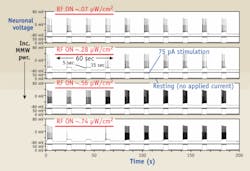LASER TISSUE INTERACTION/CELL BIOLOGY: THz in biology and medicine: Can neurons sense millimeter waves?
Above microwaves and below the far-infrared, where the spectral exposure area is no larger than your fingernail, lie the millimeter-wave bands. Their corresponding frequency range, from 30 to 300 GHz, has long been the object of desire for applications as widespread as telecommunications, ultra-high speed circuits, radar, and radio astronomy. The associated energy range, around 1 milli-electron volt, means that millimeter waves are non-ionizing and generally interact with liquids and solids through transfer of energy into broad vibrational mode bands, i.e. through heating.
Thanks to their long wavelengths, 1mm to 1cm, millimeter waves have some unique optical properties. They readily pass through many dielectrics (clothing included) but are heavily absorbed by polar liquids (water) and conductive solids. They can be focused by opaque plastic lenses and crystals but will not pass through common glass without significant loss. Gases at very low pressure can be strongly excited by millimeter-waves, which couple to unique vibrational modes that can often be used as a fingerprint for identifying the medium. At atmospheric pressure, however, these vibrational mode fingerprints are spectrally broadened, so much so that only a few extremely strong absorbers, such as water and oxygen, show up uniquely in a broad spectral sweep.
As electronic technologies have advanced, generating and detecting millimeter waves have become easier and less costly. But despite the proliferation of applications, it is very difficult to find any U.S. civilian agency that is actively funding research on the biological impact and mechanisms for millimeter wave interactions with tissue. Exposure safety standards are based on observations of tissue lesions with the energy transfer mechanism assumed to be purely thermal. A few investigators have looked for more subtle millimeter wave interactions but typically at power densities that are well above the current U.S. government standard for maximum permissible exposure (MPE) 1mW/cm2 for six minutes. Lower power effects, although sought for many years, have not been definitively observed.
Evidence of biological process impact
During the SPIE's Biomedical Optics Symposium (BiOS) at Photonics West 2010, however, a neurophysiologist, Dr. Victor Pikov, at the Huntington Medical Research Institutes, and an electrical engineer, Dr. Peter Siegel, from the California Institute of Technology (both in Pasadena, California), reported the first compelling evidence that very low intensity millimeter-waves can strongly impact biological processes.1 The paper they presented detailed findings that millimeter-wave power exposures at 60 GHz of less than 0.3 microwatts/cm2 for 1 minute–which is more than 3000 times lower than the MPE–triggered strong neuronal responses in cortical slices from 13- to 16-day-old rat pups.
The researchers observed both inhibition and enhanced excitation of the action potential (AP) firing rate in measurements on eight individual pyramidal neurons using a patch-clamp measurement arrangement (see Fig. 1). The setup used vertically coupled millimeter-wave power source (Impatt oscillator and WR15 output waveguide) to expose cortical slices immersed in artificial cerebro-spinal fluid. During experiments, neuron activity (AP firing rate) showed dramatic changes at different power levels: For the eight neurons probed, half showed significant inhibition while the other half showed either enhancement or very modest increase in the AP firing rate with increasing RF power (see Fig. 2).In addition the researchers observed consistent decreases in the individual AP duration (rise and fall times) as well as in the membrane resistance, pointing to measurable changes in membrane permeability (the opening and closing of membrane pores). They noticed no significant heating of the bath during the exposures pointing to mechanisms that more directly couple millimeter-waves to the neurons themselves, however.
Implications: Therapy potential
The findings have implications for the health and safety of millimeter wave exposure, as well as for the potential control of neuronal response through a non-invasive process. If the power levels are not a safety concern, and the millimeter wave stimulation can be configured to selectively induce specific neuronal responses, it opens the door to therapies that might be applied for pain suppression or for neuroprosthetic control of brain functions.
The researchers are hoping to continue and expand their initial work through the National Institutes of Health and other grant mechanisms. The patch clamp measurements were performed at the Huntington Medical Research Institute with the help of Dr. Michael Harrington and Dr. Xianghong Arakaki. Additional experiments were performed at the California Institute of Technology under the support of Professor Scott Fraser (biology) and Professor David B. Rutledge (electrical engineering).
Reference
- P.H. Siegel and V. Pikov, SPIE Photonics West, BiOS, paper 7562-17, 2010.

Barbara Gefvert | Editor-in-Chief, BioOptics World (2008-2020)
Barbara G. Gefvert has been a science and technology editor and writer since 1987, and served as editor in chief on multiple publications, including Sensors magazine for nearly a decade.

